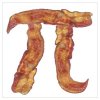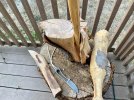- Joined
- Mar 31, 2018
- Messages
- 2,759
It all depends whether you want to do damage to the log you are splitting or the knife you are using.
And how much of the pie it takes to replenish your strength after the testing. But it could also be best to just save the knife to slice pie and relax and let someone with the proper wisdom worry about the issue.
And how much of the pie it takes to replenish your strength after the testing. But it could also be best to just save the knife to slice pie and relax and let someone with the proper wisdom worry about the issue.




